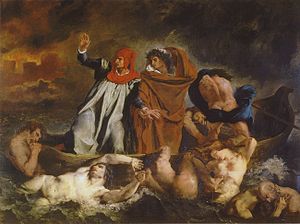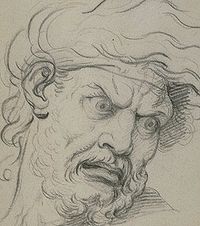- The Barque of Dante
-
The Barque of Dante 
Artist Eugène Delacroix Year 1822 Type Oil on canvas Dimensions 189 cm × 246 cm (74 in × 95 in) Location Louvre, Paris The Barque of Dante, sometimes known as Dante and Virgil in Hell, is the first major painting[1] by the French artist Eugène Delacroix, and is one of the works signalling a shift in the character of narrative painting from Neo-Classicism towards the Romantic movement. It was completed in time for the opening of the Salon of 1822 and currently hangs in the Musée du Louvre, Paris.[2]
The painting is loosely based on fictional events taken from canto eight of Dante’s Inferno. A leaden, smoky mist and the blazing City of the Dead form the backdrop against which the poet Dante endures a fearful crossing of the River Styx. He is steadied by the learned poet of antiquity Virgil as they plough through waters heaving with tormented souls.
The arrangement of figures is for the most part compliant with the tenets of the cool, reflective Neo-Classicism that had dominated French painting for nearly four decades. There is a group of central upright figures, and a rational arrangement of subsidiary figures, all in horizontal planes, and observing studied poses.
Contents
Themes
 Géricault’s The Raft of the Medusa was a powerful influence for Delacroix.
Géricault’s The Raft of the Medusa was a powerful influence for Delacroix.
The Barque of Dante was an artistically ambitious work, and although the composition is conventional, the painting in some important respects broke unmistakably free of the French Neo-Classical tradition.
The smoke to the rear and the fierce movement of the garment in which the oarsman Phlegyas is wrapped indicate a strong wind, and most of the individuals in the painting are facing into it. The river is choppy and the boat is lifted to the right, a point at which it is twisted toward the viewer. The party is driven to a destination known to be yet more inhospitable, by an oarsman whose sure-footed poise in the storm suggests his familiarity with these wild conditions. The city behind is a gigantic furnace. There is neither comfort nor a place of refuge in the painting’s world of rage, insanity and despair.
 Charles Le Brun’s, La Colère of 1668.
Charles Le Brun’s, La Colère of 1668.
The painting explores the psychological states of the individuals it depicts, and uses compact, dramatic contrasts to highlight their different responses to their respective predicaments. Virgil’s detachment from the tumult surrounding him, and his concern for Dante’s well-being, is an obvious counterpoint to the latter’s fear, anxiety, and physical state of imbalance. The damned are either rapt in a piercing concentration upon some mad and gainless task, or are else apparently in a state of total helplessness and loss. Their lining of the boat takes an up-and-down wave-like form, echoing the choppy water and making the foot of the painting a region of perilous instability. The souls to the far left and right are like grotesque bookends, enclosing the action and adding a claustrophobic touch to the whole.
Delacroix wrote that his best painting of a head in this picture is that of the soul reaching with his forearm from the far side into the boat.[3] Both Charles Le Brun’s, La Colère of 1668, and John Flaxman’s line engraving The Fiery Sepulchres, appearing as plate 11 in The Divine Poem of Dante Alighieri, 1807, are likely sources for this head.[4]
The theatrical display of bold colours in the figures at the centre of the composition is striking. The red of Dante’s cowl resonates alarmingly with the fired mass behind him, and vividly contrasts with the billowing blue about Phlegyas. The author Charles Blanc noted the white linen on Virgil’s mantle, describing it as a ‘great wake up in the middle of the dark, a flash in the tempest’.[5] Adolphe Loève-Veimars commented on the contrast between the colours used in Dante’s head, and in the depiction of the damned, concluding that all this ‘leaves the soul with I know not what fell impression’.[6] [7]
Water drops on the damned
 Juxtaposed white, green, yellow and red pigments.
Juxtaposed white, green, yellow and red pigments.
The drops of water running down the bodies of the damned are painted in a manner seldom seen up to and including the early nineteenth century. Four different, unmixed pigments, in discretely applied quantities comprise the image of one drop and its shadow. White is used for highlighting, strokes of yellow and green respectively denote the length of the drop, and the shadow is red.
Delacroix’s pupil and chief assistant of over a decade, Pierre Andrieu, recorded that Delacroix had told him the inspiration for these drops had come in part from the water drops visible on the nereids in Rubens’ The Landing of Marie de’ Medici at Marseilles, and that the drops on The Barque of Dante were Delacroix’s point of departure as a colourist.[8] Lee Johnson discussing these drops comments that “the analytical principle [Delacroix] applies of dividing into pure coloured components an object that to the average eye would appear monochrome or colourless, is of far-reaching significance for the future.”[9]
Background
 Head of a creature seizing the vessel
Head of a creature seizing the vessel
In a letter to his sister, Madame Verninac, written in 1821, Delacroix speaks of his desire to paint for the Salon the following year, and to ‘gain a little recognition’.[10] In April 1822 he wrote to his friend Charles Soulier that he had been working hard and non-stop for two and a half months to precisely that end. The Salon opened on April 24, 1822 and Delacroix’s painting was exhibited under the title Dante et Virgile conduits par Phlégias, traversent le lac qui entoure les murailles de la ville infernale de Dité.[11] The intense labour that was required to complete this painting in time left Delacroix weak and in need of recuperation.[12]
Critics expressed a range of opinions about The Barque of Dante. One of the judges at the Salon, Étienne-Jean Delécluze, was uncomplimentary, calling the work ‘a real daub’ (une vraie tartouillade). Another judge, Antoine-Jean Gros, thought highly of it, describing it a ‘chastened Rubens’.[13] An anonymous reviewer in Le Miroir expected Delacroix to become a ‘distinguished colourist’.[14] One particularly favourable piece of criticism from up-and-coming lawyer Adolphe Thiers received wide circulation in the liberal periodical Le Constitutionnel.[15] [16]
In the summer of 1822, the French State purchased the painting for 2000 Francs, and moved it to the Musée du Luxembourg. Delacroix was delighted on hearing the news, although he feared the piece would be less admired for being viewed at close quarters. Some two year later he revisited the painting, reporting that it gave him much pleasure, but describing it as being insufficiently vigorous; a deficiency he had identified in the painting he was working on at the time, The Massacre at Chios.[17][18][19] The painting was moved in 1874—eleven years after the death of the artist—to its present location, the Musée du Louvre.[20]
See also
- The Raft of the Medusa
- Dante And Virgil In Hell by William-Adolphe Bouguereau, a painting using the same title.
References
- ^ A World History of Art, Hugh Honour and John Fleming, Macmillan Reference Books, 1982, isbn 0333235835. Page 487.
- ^ Musée du Louvre
- ^ Journal de Eugène Delacroix, Tome Ⅱ;, 1822–1852, André Joubin, Librairie Plon, 8 rue Garancière, Paris, 1932, entry for December 24, 1853. Pages 136, 137. http://www.jonathanriley.net/dvh.html#y1853_m12_d24
- ^ The Paintings of Eugène Delacroix, A Critical Catalogue, 1816-1831, Volume One, Lee Johnson, Oxford University Press, 1981. Page 76.
- ^ Charles Blanc, ‘Grammaire des arts du dessin’, GBA, ⅹⅹ (1866). Page 382.
- ^ Adolphe de Loëve Veimars, ‘Salon de 1822’, Album, June 10, 1822. Page 262.
- ^ The Paintings of Eugène Delacroix, A Critical Catalogue, 1816-1831, Volume One, Lee Johnson, Oxford University Press, 1981. Page 76.
- ^ Les Palettes de Delacroix, René Piot, Librairie de France, Paris, 1931. Pages 71-74. http://www.jonathanriley.net/dvh.html#andrieu_dante_et_virgile_aux_enfers
- ^ Delacroix, Lee Johnson, W.W.Norton & Company, Inc., New York, 1963. Pages 18, 19.
- ^ Delacroix’s letter to his sister, Madame Verninac, July 26, 1821. Taken from: Correspondance Générale de Eugène Delacroix, Supplément et Tables, André Joubin, Librairie Plon, Paris, 1938. Page 91. http://www.jonathanriley.net/dvh.html#y1821_m07_d26
- ^ Explication des Ouvrages de Peinture, Sculpture, Architecture et Gravure, des Artistes Vivans, Exposés au Musée Royal des Arts. C. Ballard. Rue J.-J. Rousseau, No 8. April 24, 1822. http://www.jonathanriley.net/dvh.html#y1822_m04_d24
- ^ Delacroix’s letter to his friend, Charles Soulier, April 15, 1822. Taken from: Correspondance Générale de Eugène Delacroix, Tome Ⅰ, André Joubin, Librairie Plon, Paris, 1936. Pages 140, 141. http://www.jonathanriley.net/dvh.html#y1822_m04_d15
- ^ The Paintings of Eugène Delacroix, A Critical Catalogue, 1816-1831, Volume One, Lee Johnson, Oxford University Press, 1981. Page 75.
- ^ Le Miroir des Spectacles, des Lettres, des Mœurs et des Arts, edited by M.M. Jouy, A.V. Arnault, Emmanuel Dupaty, E. Gosse, Cauchois-Lemaire, Jal, et al, Paris, May 1, 1822. Page 3. http://jonathanriley.net/dvh.html#y1822_m05_d01
- ^ Salon de Mil Huit Cent Vingt-Deux, M.A. Thiers, Maradan, Paris, 1822. Pages 56-58. http://www.jonathanriley.net/dvh.html#thiers_book_salon_1822
- ^ Dante et Virgile aux Enfers D'Eugene Delacroix, Sébastien Allard, Louvre, Paris, 2004, isbn 271184773x. Page 34.
- ^ Journal de Eugène Delacroix, Tome Ⅰ, 1822-1852, André Joubin, Librairie Plon, 8 rue Garancière, Paris, 1932, entry for September 3, 1822. Page 3. http://www.jonathanriley.net/dvh.html#y1822_m09_d03
- ^ Delacroix’s letter to his friend, Félix Guillemardet, September 4th, 1822. Taken from: Eugène Delacroix, Lettres Intimes, Alfred Dupont, Gallimard, Paris, 1954. Pages 139-142. http://www.jonathanriley.net/dvh.html#y1822_m09_d04
- ^ Journal de Eugène Delacroix, Tome Ⅰ, 1822-1852, André Joubin, Librairie Plon, 8 rue Garancière, Paris, 1932, entry for April 11, 1824. Page 72. http://www.jonathanriley.net/dvh.html#y1824_m04_d11
- ^ The Paintings of Eugène Delacroix, A Critical Catalogue, 1816-1831, Volume One, Lee Johnson, Oxford University Press, 1981. Page 72. http://www.jonathanriley.net/dvh.html#catalogue jonathanriley.net
Eugène Delacroix Artworks The Barque of Dante · Orphan Girl at the Cemetery · The Massacre at Chios · Greece on the Ruins of Missolonghi · Death of Sardanapalus · Liberty Leading the People · The Women of Algiers · Battle of Taillebourg · Entry of the Crusaders in Constantinople · Ovid among the Scythians · Last Words of the Emperor Marcus Aurelius · A Young Tiger Playing with its Mother
Family Charles-François Delacroix · Charles Maurice de Talleyrand-Périgord · Henri-François Riesener · Jean-Henri RiesenerColleagues Teachers Museums Louvre · Art Institute of Chicago · Minneapolis Institute of Arts · National Gallery, London · Metropolitan Museum of Art · Musée national Eugène Delacroix · Musée des Beaux-Arts de Lyon · Museu de Arte de São PauloStyle Categories:- Romantic paintings
- 1822 paintings
- Paintings of the Louvre
- Eugène Delacroix paintings
- Dante Alighieri
Wikimedia Foundation. 2010.
